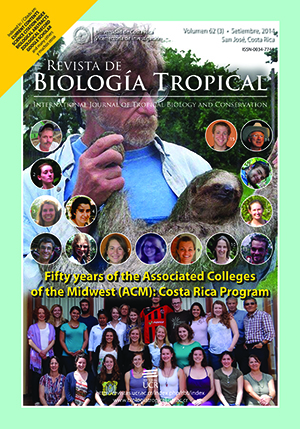Abstract
Knowledge of ecological impacts of exotic beach almond (Terminalia catappa) in the central Pacific of Costa Rica are little known, but studies have found this species to be a potentially important food source for endangered scarlet macaws (Ara macao). In this study, reproductive phenology and seed predation by variegated squirrels (Sciurus variegatoides) and scarlet macaws were measured during March and April 2011 on beaches of central Pacific coastal Costa Rica. Seed productivity and predation levels were quantified on a weekly basis for 111 beach almond trees to assess the importance of beach almond as a food source for scarlet macaws and the extent of resource partitioning between seed predators. Seed production of the trees was great (about 194 272 seeds) and approximately 67% of seeds were predated by seed predators. Macaws consumed an estimated 49% of seeds while squirrels consumed 18%. Additionally, evidence of resource partitioning between squirrels and macaws was found. Scarlet macaws preferred to feed on the northern side and edge of the canopy while squirrels preferred to feed on the southern and inside parts of the canopy. Both species ate most seeds on the ocean side of the tree. Despite the status of this tree as an exotic species, the beach almond appears to be an important resource for scarlet macaw population recovery. The resource produced by this tree should be taken into account as reforestation efforts continue in Costa Rica.
Jonathan J. Henn1, Michael B. McCoy2, Christopher S. Vaughan2
1 Biology Department, St. Olaf College, 1500 St. Olaf Ave, Northfield, MN, USA. henn.jonathan@gmail.com
2 Associated Colleges of the Midwest Costa Rica Program, San Jose, Costa Rica. mmccoycolton@yahoo.com, cvaughan@acm.edu
##plugins.facebook.comentarios##

This work is licensed under a Creative Commons Attribution 4.0 International License.
Copyright (c) 2014 Revista de Biología Tropical






